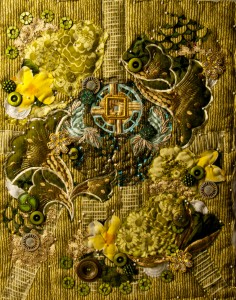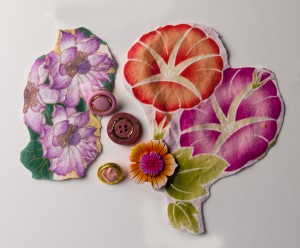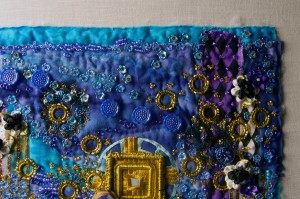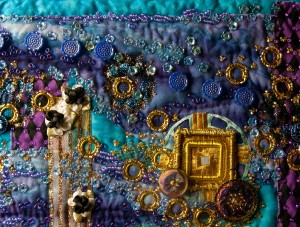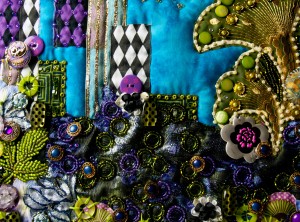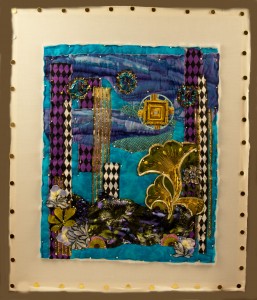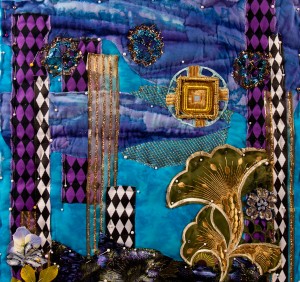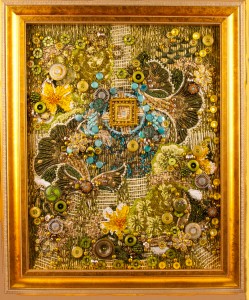 Tapping into a person’s energy field is not a usual way to see the image for creating an art quilt, but that’s exactly what I do for this series of “Meditation Art Quilts”. They’re designed to be the perfect place for that person to view, use as a meditation focus, and energetically play in. Such is the case of this latest piece, “Milly’s Garden”, a small art quilt, (16″ x 20″ or 41.5cm x 50 cm, without the frame.) The central portal is the entrance and exit to the garden, and if you go to the page on this blog that tells about them, there are the phrases to help you access any of the images that I’ve created so far. (Feel free to access the energy in any of the images that appeal to you; all can share!)
Tapping into a person’s energy field is not a usual way to see the image for creating an art quilt, but that’s exactly what I do for this series of “Meditation Art Quilts”. They’re designed to be the perfect place for that person to view, use as a meditation focus, and energetically play in. Such is the case of this latest piece, “Milly’s Garden”, a small art quilt, (16″ x 20″ or 41.5cm x 50 cm, without the frame.) The central portal is the entrance and exit to the garden, and if you go to the page on this blog that tells about them, there are the phrases to help you access any of the images that I’ve created so far. (Feel free to access the energy in any of the images that appeal to you; all can share!)
I was especially pleased with the bands of translucent. pale green ribbon that lead from the central portal. In this full pic, they are the bands with horizontal, pale green seed beads. Dark green lilies frame the central portal, and the edges of the tops of the flowers suggest green clouds. (This piece is for my Mother and her favorite color is green.)
 This detail shot shows the edges of one of those green lilies and how I used seed beads to emphasize the shape of the flower. Tiny, cream colored pearls were shown along the outer edge of satin stitch that was commercially done on the fabric. I sewed dark olive beads vertically upwards from the base of the flower to suggest veins. To the right of the flower is some of the blue and gold metallic lace that was sewn around the central gold portal to also suggest clouds. It takes quite a bit of hand quilting to get lace with motifs as spread out as this to lie flat, so I used some metallic blue seed beads to add on to the lace and to weigh it down. There are two glass buttons from Czechoslovakia that I’ve written about in a previous blog. There’s a green one on the lower left edge, and black and gold one in the bottom middle in this photo. People always respond to these glass buttons, and reach out to touch them as they are so unusual. I always try to include some in each art quilt that I make because of the response that they elicit.
This detail shot shows the edges of one of those green lilies and how I used seed beads to emphasize the shape of the flower. Tiny, cream colored pearls were shown along the outer edge of satin stitch that was commercially done on the fabric. I sewed dark olive beads vertically upwards from the base of the flower to suggest veins. To the right of the flower is some of the blue and gold metallic lace that was sewn around the central gold portal to also suggest clouds. It takes quite a bit of hand quilting to get lace with motifs as spread out as this to lie flat, so I used some metallic blue seed beads to add on to the lace and to weigh it down. There are two glass buttons from Czechoslovakia that I’ve written about in a previous blog. There’s a green one on the lower left edge, and black and gold one in the bottom middle in this photo. People always respond to these glass buttons, and reach out to touch them as they are so unusual. I always try to include some in each art quilt that I make because of the response that they elicit.
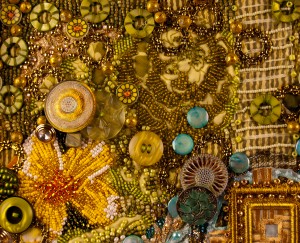 This detail shot, from the upper left of the portal, shows some of the extensive beading that I do. On the far right is a detail of the translucent, pale green ribbon that I mentioned above with it’s alternating horizontal rows of pale green seed beads. The yellow plumeria flower in the far, bottom left is a motif cut from fabric. It measures about 4″ x 4″ ( 10 cm x 10 cm) and is completely covered with seed beads. That intensive an amount of beading takes about 1 hour to complete 1 sq. in. (2.5 sq cm). In the middle of this shot are some pale green flowers where I left some of the fabric showing for future art historians. You can also see how I repeated lots of circles to help tie the composition together. The buttons are circular, there are some flat gold metal wreaths in the very top middle edge, and to the far left are some of those dyed shell circles that I stitched down with 6 strands of a darker shade of green in embroidery floss. By repeating shapes and colors, I can use a diverse amount of materials, and in my opinion, have them work as a balanced composition.
This detail shot, from the upper left of the portal, shows some of the extensive beading that I do. On the far right is a detail of the translucent, pale green ribbon that I mentioned above with it’s alternating horizontal rows of pale green seed beads. The yellow plumeria flower in the far, bottom left is a motif cut from fabric. It measures about 4″ x 4″ ( 10 cm x 10 cm) and is completely covered with seed beads. That intensive an amount of beading takes about 1 hour to complete 1 sq. in. (2.5 sq cm). In the middle of this shot are some pale green flowers where I left some of the fabric showing for future art historians. You can also see how I repeated lots of circles to help tie the composition together. The buttons are circular, there are some flat gold metal wreaths in the very top middle edge, and to the far left are some of those dyed shell circles that I stitched down with 6 strands of a darker shade of green in embroidery floss. By repeating shapes and colors, I can use a diverse amount of materials, and in my opinion, have them work as a balanced composition.
Creating these meditation gardens is great, good fun for me, as I feel that I am giving an image to something that the person is about, their own personal energy field. I already have some people interested in having me do one for them, so I hope that you get called to have one made for you. Please pass this blog on to like minded souls, whom you think would like to have a piece made for them. I’d love to create one for you, as we all need a personal space in which to mediate and reflect. What better place than a personal garden based on yourself in which to revel?
How do you go about making choices as to what appears in your art work? Which sorts of elements call to you the most when you’re designing in your own medium?
Why not leave a comment as to your thoughts on this posting. Please take a minute, fill out the form below or by clicking on the “comments/no comments link” at the top of the posting, and then share your ideas with the rest of us. We all grow when we share our thoughts and impressions, so why not join our growing community of those who appreciate art quilts and textile arts. We’d love to hear from you!… and PLEASE tell like minded souls about this blog! The more readers and contributors, the more I write.
You can see more of my art work on my web site at www.fiberfantasies.com (be patient as it loads; it’s worth it), my healing work at www.hearthealing.net and can find me on Google + , Facebook (for Transition Portals) Facebook (for Fiber Fantasies), and Twitter.
To find out how to buy my art work, please check out “How to Buy my Art Work” in the “Pages” section to the right of this blog.

